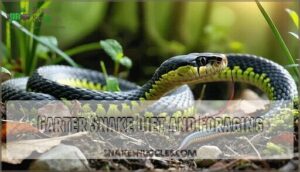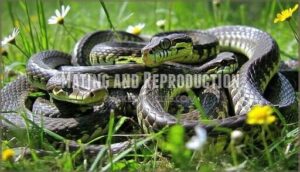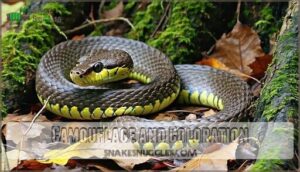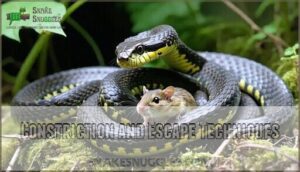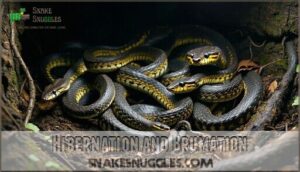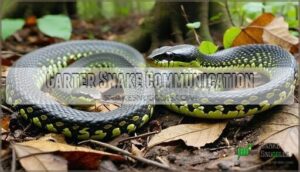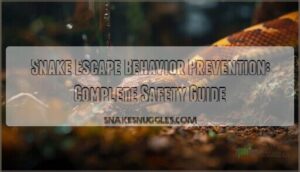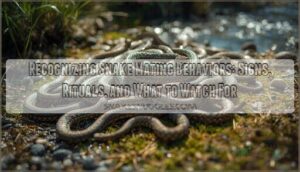This site is supported by our readers. We may earn a commission, at no cost to you, if you purchase through links.

When cornered, they might release a foul-smelling musk to defend themselves. Some are bold and curious, while others are timid, which affects how they interact with their environment.
These adaptable snakes thrive in various habitats, from marshes to gardens, and play a big role in controlling pests like insects and small rodents.
Social during brumation (a type of hibernation), they often gather in groups for warmth. Curious about their unique survival skills or social habits? There’s more to explore!
Table Of Contents
- Key Takeaways
- Garter Snake Social Structure
- Snake Personality Types
- Habitat and Distribution
- Garter Snake Diet and Foraging
- Mating and Reproduction
- Defensive Mechanisms and Threat Response
- Hibernation and Brumation
- Garter Snake Communication
- Conservation Status and Threats
- Human Interaction and Coexistence
- Frequently Asked Questions (FAQs)
- What is garter snake behavior?
- Do garter snakes form social bonds?
- What adaptations do garter snakes have?
- Are garter snakes social?
- What is the personality of a garter snake?
- How do garter snakes behave?
- What is the social behavior of a garter snake?
- Are garter snakes friendly?
- How fast can garter snakes move?
- Do garter snakes make good pets?
- Conclusion
Key Takeaways
- Garter snakes are shy and non-aggressive, often fleeing from threats or releasing a foul-smelling musk when cornered.
- They form social bonds and recognize family members, especially during brumation when they gather in groups for warmth.
- Personality traits, like boldness or shyness, influence their survival strategies, hunting behaviors, and interactions with other snakes.
- These adaptable snakes thrive in diverse habitats and play a crucial role in controlling pests like insects, frogs, and small rodents.
Garter Snake Social Structure
You’ll be surprised to learn that garter snakes aren’t loners but form complex social communities where they recognize family members and develop preferences for certain companions.
Garter snakes form surprising social bonds, preferring specific companions and recognizing family members in their vibrant, close-knit communities.
These social structures help them with survival tasks like finding warm spots together during cold months and protecting each other from predators.
Forming Social Bonds
Did you know garter snakes aren’t the loners most people imagine? These fascinating reptiles actually form genuine social bonds with specific snakemates, creating intricate social hierarchies within their communities.
When forming friendships, garter snakes demonstrate:
- Kin recognition abilities, often preferring to associate with relatives
- Group thermoregulation behaviors, where they cuddle together for warmth
- Scent communication patterns that establish and maintain relationships
- Friendship evidence through consistent proximity preferences with specific individuals
Research shows these social bonds aren’t random—garter snakes deliberately choose their companions based on familiarity, sex, and age.
Older females typically have the most extensive social networks, serving as community hubs.
These snake "friendships" offer survival advantages, including better predator protection and more efficient temperature regulation.
Snake temperament plays a vital role too, as individuals with compatible personality traits tend to form stronger, longer-lasting social bonds.
Influence of Personality Traits
Did you know garter snakes have distinct personalities? You’ll find bold individuals who explore more territory, gaining the Boldness Advantage in finding resources.
Their shy counterparts excel at Shy Survival, staying hidden from predators. Snake temperament isn’t fixed—Personality Plasticity allows them to adapt to changing conditions.
Habitat Influence shapes these traits, with garter snake behavior often reflecting their environment. Researchers believe some traits show Trait Inheritance patterns across generations.
Garter snakes use tail movements and vibrations as warning signals to deter threats.
Snake Personality Types
You’ll find that garter snakes have distinct personalities, ranging from bold explorers who readily investigate new surroundings to shy individuals who prefer to remain hidden.
These personality differences affect how they interact with other snakes, respond to threats, and adapt to their environments, making them distinct in how they behave.
Bold and Shy Classification
Among garter snakes, researchers have identified distinct personality types that affect their survival strategies.
These snakes fall into two main categories:
- Bold individuals actively explore their surroundings, showing higher risk tolerance when seeking food or mates, while shy snakes prefer staying hidden, minimizing predation risk.
This personality inheritance remains consistent throughout their lives. Bold snakes demonstrate different stress responses and learning differences compared to their cautious counterparts.
Their exploration tendencies directly impact how they interact with their environment and handle threats. Garter snakes use tail movements as warnings to deter potential predators.
Impact on Social Behavior
While we’ve seen that garter snakes can be bold or shy, their social behavior isn’t as simple as their personality type.
In groups, even shy snakes may act differently than when alone. Your backyard garter snakes practice "group thermoregulation" – literally cuddling together for warmth.
They also use scent marking to establish territories and can actually recognize family members. Social learning plays a key role too, with snakes watching and learning from each other’s boldness impact on finding food and avoiding danger.
Adaptations for Survival
Personality traits directly influence how garter snakes survive in the wild.
Their scale adaptations provide perfect camouflage effectiveness, letting them disappear against forest floors and grassy areas.
You’ll notice their venom variations are mild but effective for prey capture without threatening humans.
When temperatures drop, they’ve mastered temperature regulation through group hibernation.
Some species even show remarkable aquatic adaptations, swimming efficiently to escape predators or hunt.
These behavioral adaptations aren’t just fascinating—they’re the reason these clever reptiles have thrived for millions of years despite countless predator avoidance challenges.
Habitat and Distribution
You’ll find garter snakes in a surprising variety of homes across North America, from your backyard garden to wetlands, forests, and grassy meadows.
They’re adaptable creatures that prefer areas with access to water sources and plenty of hiding spots like rocks, logs, and dense vegetation.
Preferred Environments
Where do garter snakes choose to call home? These adaptable reptiles thrive in environments with consistent moisture and plenty of hiding spots. Their habitat preferences center around reliable water sources, making wetlands and stream edges ideal locations.
- Garden habitats with dense vegetation provide perfect shelter requirements
- Urban adaptations allow them to survive in parks and residential areas
- Microhabitat preferences include south-facing slopes for basking
Garter snakes carefully select hibernacula based on temperature stability and protection from predators. They’re drawn to microclimates that balance warmth and moisture throughout changing seasons. They also exhibit varied hunting strategies, depending on prey availability.
Geographic Range and Variations
Spanning a vast geographic range, garter snakes thrive across North America, adapting to wetlands, forests, deserts, and backyards.
These reptiles showcase remarkable habitat adaptation, with regional subspecies featuring distinct color variations and size differences. For instance, Valley garter snakes in Oregon display a bright yellow stripe, while Maritime garter snakes in the Northeast exhibit diverse patterns.
Their adaptability even includes surviving introduced populations in urban areas. To guarantee their well-being, consider suitable habitat products.
Species variation reflects local climates, from Canada’s cold forests to Mexico’s heat. This incredible resilience highlights garter snake behavior and temperament, showing how they embrace unique environments with camouflage and cunning survival tactics.
Human Impact on Habitats
Human activity shapes where garter snakes can live. From bustling cities to expanding farms, habitat fragmentation caused by urban encroachment and agriculture reduces the spaces these snakes call home.
Pollution effects, like polluted waterways, hurt their main food sources, such as amphibians and fish. Climate change effects add another level of challenge by altering temperatures and disrupting their ecosystems.
To help these adaptable snakes survive, conservation efforts focus on protecting their habitats and educating people about coexisting with wildlife.
You can make a difference too:
- Support local conservation programs to preserve ecosystems.
- Avoid littering and reduce water pollution.
- Leave logs and rocks undisturbed; they’re garter snake shelters.
- Keep pets from damaging natural habitats.
- Promote sustainable farming practices.
Garter Snake Diet and Foraging
Garter snakes eat a variety of small animals, including frogs, fish, insects, and earthworms. They rely on their keen senses and quick movements to locate and capture prey effectively.
Primary Food Sources
In terms of their diet, garter snakes are true opportunists.
They thrive on Amphibian Consumption, Rodent Predation, and an Insect Diet, adjusting to Seasonal Variation in prey.
From hopping frogs in spring to slippery fish or earthworms, they’re not picky.
Dietary Adaptations help them survive shifts in food supply, keeping these snakes resourceful.
Their snake diet highlights nature’s clever balance, ensuring survival through flexible foraging strategies and diverse prey options.
Hunting Strategies and Techniques
Your slippery garden companion has mastered remarkable hunting techniques. With foraging strategies that adapt to their prey, they switch between ambush predation and active pursuit.
Through scent tracking, they stalk frogs in wetlands, while some wait patiently to strike at earthworms. Their mild venom usage and seasonal adjustments to diet guarantee success in the complex webs of predator-prey dynamics.
Supplementing their diet can be achieved with specialized snake food. It’s survival, fine-tuned to perfection!
Adaptations for Prey Capture
A garter snake’s hunting arsenal is a mix of speed, precision, and adaptability.
Their vibration detection, sharp vision, and chemical signals make prey impossible to miss.
With venom variations and agile strikes, they subdue small prey quickly.
Their jaw flexibility helps swallow meals whole, showcasing unmatched prey specialization.
Add to that their impressive constriction strength and stealthy hunting techniques, and you’ve got a predator fully adapted for survival in diverse habitats.
Mating and Reproduction
Garter snakes have unique mating habits, often gathering in large groups during the breeding season. Females give birth to live young, skipping the egg-laying process seen in many other snakes.
Mating Habits and Rituals
As spring awakens the garter snakes, their mating rituals begin with males tracking females using pheromone trails.
During this season, you might see females at the center of remarkable mating balls, with dozens of males competing to mate.
These courtship displays include:
- Pheromone-driven tracking for precise mate location.
- Mating dances showcasing strength and agility.
- Communal gatherings that highlight timeless garter snake behavior.
Successful males guarantee reproductive timing aligns perfectly for offspring survival.
Nesting and Egg-Laying
After fascinating courtship and mating rituals, female snakes skip traditional egg-laying.
Instead, they incubate embryos internally for 2-3 months. Nest sites like rotting logs or soft soil provide warmth to aid embryonic development.
Mothers give birth to live young, producing 20-40 at once.
| Term | Explanation |
|---|---|
| Egg Deposition | Internal incubation, not external |
| Clutch Size | 20-40 hatchlings |
| Nest Site | Logs, soft soil |
| Hatchling Survival | Sheltered conditions critical |
Parental Care and Young Development
Maternal care in garter snakes might surprise you! These creatures invest in their young well before birth through a gestation period involving matrotrophy, where nourishment is provided internally.
After a live birth, mothers actively guard their neonates for the first 24 to 48 hours, a vital period for newborn survival. Once the young begin exploring, they rely on instinct and early experiences to navigate their environment.
Garter snake babies may leave mom quickly, but their journey to independence is fascinating. Within days, they’re perfecting their juvenile diet, recognizing prey through early learning, and avoiding predators.
- Newborns disperse rapidly to reduce competition.
- Neonates hunt tiny prey like insects and earthworms.
- Siblings occasionally coordinate early hunts.
- Babies master chemical cues to detect danger.
- Mothers exhibit short-term parental investment to boost survival.
Defensive Mechanisms and Threat Response
Garter snakes have clever ways to protect themselves when they feel threatened. They blend into their surroundings, release a strong-smelling musk, or quickly slither away to escape danger.
Camouflage and Coloration
Nature’s ingenious designs shape a garter snake’s survival, with its color variations and scale patterns perfectly suited for predator avoidance.
These snakes display striking color patterns—dark stripes for forests, mottled tones for grasslands, and red or yellow accents in wetlands.
This environmental adaptation guarantees they melt into their surroundings like a leaf in a forest or a shadow on a sunny field.
Their camouflage effectiveness isn’t sheer luck; it’s a finely tuned strategy, hiding them from sharp-eyed predators while helping them become stealthy hunters.
Release of Foul-Smelling Secretions
When danger strikes, garter snakes release their own tiny stink bomb: a foul-smelling musk.
This defensive mechanism is backed by science. The musk, crafted from acids like acetic and butanoic, sends predators running.
Here’s how it works:
- Musk Composition: Each species creates a unique odor.
- Odor Variation: Smell and taste repel predators instantly.
- Secretion Control: Snakes can accurately aim the spray.
- Human Reaction: Handle them? Prepare for the stink!
This is classic garter snake behavior at its finest.
Constriction and Escape Techniques
Garter snakes are masters of defensive tricks, blending skill with instinct.
They use prey suffocation by constriction, applying muscle strength to control prey. For escape, burrowing escape and rapid movements are key.
Their snake temperament shifts defensively, using scale friction for gripping terrain or curling into coils when under attack. Although biting is rare, jaw flexibility can help them snag prey.
These defensive mechanisms show how garter snakes balance predator-prey dynamics for survival.
Hibernation and Brumation
When winter comes, garter snakes enter a state called brumation to survive the cold. They gather in large groups in hidden places, slowing down their bodies to conserve energy.
Preparation for Dormancy
As winter nears, garter snakes prepare for brumation by hunting actively to build critical body fat.
These resourceful reptiles scout dens in rock crevices or burrows, focusing on spots ideal for energy conservation. They also balance hydration levels before settling in.
Key preparation steps include:
- Den Selection: Choosing stable sites to withstand cold.
- Food Consumption: Eating frogs or mice to stockpile energy.
- Brumation Timeline: Timing entry before freezing temperatures hit.
Physiological Changes During Brumation
As temperatures drop, garter snakes prepare for brumation, showcasing amazing physiological changes that help them outlast harsh conditions.
It’s like nature’s version of hitting the pause button. Here’s what’s happening under their scaly skin:
- Metabolic Slowdown: Their heartbeat and organ activity slow to conserve energy.
- Body Temperature: They match their surroundings, staying just warm enough to survive.
- Energy Conservation: Fat reserves become their fuel, like living off snacks in winter.
- Water Retention: Snakes avoid dehydration thanks to reduced activity.
Hibernation is vital for their survival, mimicking natural conditions and enhancing reproduction, so hibernation is essential for garter snakes.
These metabolic changes and thermoregulation tactics are key survival tools, keeping these fascinating ectotherms alive until spring.
Emergence and Post-Brumation Behavior
As spring’s warmth returns, garter snakes end brumation and jumpstart their post-brumation activity.
They focus on energy replenishment by basking in the sun and hunting. Thermoregulation basking helps regain strength for survival.
Post-Brumation mating is key, with males gathering in groups to court females. However, predation risks rise as they’re more visible to predators.
| Key Activity | Description |
|---|---|
| Energy Replenishment | Hunting small prey nearby. |
| Basking | Absorbing sunlight to warm up. |
| Grouping | Staying close for protection. |
| Mating Season | Males compete for mates. |
| Predator Avoidance | Staying alert near predators. |
Garter Snake Communication
Garter snakes communicate in unique ways, using pheromones, body movements, and vibrations to share information. These methods help them find mates, mark trails, and interact with their environment effectively.
Pheromone Signals and Trails
Snakes have a clever way of staying connected using pheromones, their very own chemical communication system. These scent trails act like invisible highways, guiding others to food, mates, or safe spots.
Garter snakes rely on their forked tongue reception to "taste" these chemical signals in the air.
Curiously, females release reproductive pheromones to attract males, who can even distinguish between species through these scents. Talk about being selective! The composition of these trails can also signal hunting areas or boundaries.
- Females use pheromones to signal readiness to mate.
- Males follow scent trails left by receptive females.
- Scent trail composition helps locate feeding spots.
- Forked tongues detect pheromone-based tracking.
- Social communication signals guide group interactions effectively.
Visual Displays and Body Language
Garter snakes have a unique way of "talking" through body language.
They flatten their bodies and use postural signals, like body contortions, to seem larger when scared. Watch for tongue flicking—more than detecting smells, it’s part of their visual displays during communication.
Coloration cues and distinct scale patterns combine with head-bobbing to warn predators or communicate with nearby snakes.
These non-venomous creatures prove that snake behavior and temperament involve fascinating subtleties beyond simple movement, demonstrating complex communication.
Auditory and Vibration Signals
In the context of sound, garter snakes listen in their own unique way.
These snakes rely on sensory adaptations to “hear” the world:
- Ground vibrations are felt through their jawbones, helping track movement.
- They sense low-frequency sounds, which signal predators nearby.
- Substrate sensitivity allows them to locate prey or detect a mate’s presence.
- Even environmental noise, like rustling, enhances their communication range.
Snakes don’t hear like humans, but their vibration-based animal communication is key to survival.
Conservation Status and Threats
You mightn’t realize it, but garter snakes face serious threats from habitat destruction, pollution, and climate change. These challenges harm their populations and disrupt the delicate ecosystems they help balance.
Habitat Destruction and Fragmentation
When neighborhoods expand, garter snakes face the struggles of habitat loss and fragmentation.
Wetlands, a key habitat, often vanish under urban encroachment, leaving these adaptable snakes in tough spots.
Here’s how habitat fragmentation affects them:
| Challenge | Impact on Snakes |
|---|---|
| Roads split territories | Dangerous crossings |
| Construction shrinks hunting areas | Less food and shelter |
| Isolated snake populations | Reduced genetic diversity |
Despite their resilience, urbanization disrupts these ecosystems.
Supporting conservation strategies like protecting green spaces and reducing environmental impact can help these slender hunters survive and thrive near human developments.
Human Activities and Pollution
Regarding garter snakes, human habits can cause real trouble.
Expanding cities and farms often lead to habitat loss, making it harder for these adaptable reptiles to survive. Pollution sneaks into the scenario too, especially when chemicals reach their food or water sources.
Here’s what affects these snakes the most:
- Chemical runoff poisons water, harming snakes and their prey.
- Plastic waste turns deadly, trapping or choking them.
- Roadways split their territories, increasing accidents.
By supporting conservation efforts and cutting back on invasive species or pollution, you’re helping these harmless creatures thrive.
Climate Change and Disease
When weather gets wonky because of climate change, garter snakes face big hurdles.
Rising heat causes thermal stress, messing with their hibernation and survival. Habitat loss from floods and droughts forces snakes to shift ranges, often into riskier areas.
Plus, warmer climates spark the spread of disease vectors that weaken their immune response through suppression.
Luckily, these reptiles show impressive behavioral flexibility, adapting to survive. Still, they need help.
Protecting habitats, monitoring wild snakes for disease, and ensuring diverse prey is available are essential strategies. A balanced ecosystem gives garter snakes their best shot at keeping healthy, which is crucial for their survival and requires a balanced ecosystem.
Human Interaction and Coexistence
You can coexist with garter snakes safely by understanding their harmless nature and role in controlling pests. Knowing how to handle encounters helps protect both you and these beneficial reptiles.
Safety Precautions and Handling
When you encounter a garter snake, it’s imperative to follow safe handling techniques to guarantee everyone stays unharmed, including the snake.
These creatures are harmless but may bite if threatened.
Always approach them calmly to prevent startling them.
Use bite prevention strategies by avoiding quick movements and handling them gently.
For children’s safety, supervise interactions closely and teach kids to observe snakes without grabbing or poking.
Handling a garter snake as a pet? Be patient and use a firm yet careful grip to avoid stress.
Remember proper release protocols: after observation, return the snake to its original spot.
Never relocate them far; it could harm their survival.
For added protection, consider using specialized handling gear to minimize direct contact.
Wearing gloves can reduce the chance of a mild snake bite, but these snakes aren’t venomous and pose no significant danger.
Their snake safety guarantees coexisting peacefully with these unique reptiles.
Benefits of Garter Snakes in Ecosystems
Garter snakes are your garden’s natural pest control team, silently guarding ecosystem health.
Guardians of your garden, garter snakes naturally control pests while preserving the delicate balance of a thriving ecosystem.
These amazing reptiles munch on slugs, insects, and small rodents that threaten crops.
Here are their top ecosystem benefits:
- Biodiversity support: They help predators and prey thrive by maintaining the food web.
- Species interaction: Garter snakes connect diverse species in their environments.
- Indicator species: Their presence shows a healthy ecosystem.
- Community ecology: They balance populations naturally.
Management and Control of Snake Populations
Managing garter snake populations starts with ethical control methods.
Use habitat management like clearing debris and trimming grass to reduce hiding spots.
Install snake-proof fencing and monitor populations to prevent overgrowth.
Relocate invasive species, like bullfrogs, affecting native snakes.
Public education fosters coexistence, reducing fear and misconceptions.
Address habitat destruction and pollution by preserving wetlands.
Creating a welcoming space with rock piles and logs can further encourage their presence in a controlled manner.
Conservation efforts guarantee ecosystem balance, proving these pest controllers deserve respect—not extermination—for their role in nature’s cycle.
Frequently Asked Questions (FAQs)
What is garter snake behavior?
They’re social, often basking in groups for warmth, but mostly solitary otherwise.
They rely on camouflage for safety, release a stinky musk if scared, and prefer to escape threats.
Surprisingly, some even form “friendships!”
Do garter snakes form social bonds?
Yes, they do! Garter snakes sometimes form social groups, especially during brumation in communal dens.
Studies even show they can prefer specific "friends."
Outside these times, they’re mostly solitary, focusing on feeding and survival.
What adaptations do garter snakes have?
When life gives you stripes, use them!
Garter snakes are built to thrive with keen smell, sharp vision, camouflage, quick reflexes, and mild venom.
These adaptations help them hunt, survive predators, and navigate diverse habitats.
They have mild venom that aids in their survival and ability to thrive in various environments.
Are garter snakes social?
Garter snakes are surprisingly social for reptiles.
They gather in groups to bask, hibernate, or mate, often forming loose communities.
They even recognize family members, using touch and smell to communicate and strengthen bonds.
What is the personality of a garter snake?
Imagine a tiny ninja—quick, sly, and adaptable.
Garter snakes have unique personalities: some are bold adventurers, exploring freely, while others shyly hide.
They prefer avoiding conflicts but may act defensively when feeling threatened, which can make them seem like adaptable creatures.
How do garter snakes behave?
These snakes are curious yet cautious.
They bask in the sun, hunt actively, and often avoid confrontation.
Sometimes they gather in groups, especially to hibernate.
Their defensive moves include releasing musk or mimicking rattlers to deter predators, which can also involve releasing musk.
What is the social behavior of a garter snake?
Picture a quiet family reunion—garter snakes often gather in groups for warmth or during hibernation.
They’re social but not clingy, communicating through smell and touch, forming loose communities while mostly staying solitary outside special occasions.
Are garter snakes friendly?
They’re not exactly cuddly, but garter snakes are generally shy and non-aggressive.
While they might squirm away or release a musky smell if threatened, they’re harmless to humans and unlikely to bite without provocation.
How fast can garter snakes move?
Quick as a wind-blown leaf, garter snakes can slither at speeds up to 4-5 mph.
Their unique side-to-side “S” movement helps them navigate swiftly, whether escaping predators or darting toward prey, showing impressive agility.
Do garter snakes make good pets?
Yes, they do! Garter snakes are low-maintenance, gentle, and non-venomous.
Their small size and ease of care make them beginner-friendly.
Make certain they’ve proper habitat, food, and gentle handling to thrive as pets.
Conclusion
Have you ever thought about how garter snake behavior and temperament impact their survival?
These adaptable, pest-controlling reptiles reveal a balance between boldness and caution, thriving in diverse habitats.
Their social habits, defensive strategies, and unique communication methods showcase their fascinating complexity.
Whether they’re foraging, brumating, or evading threats, garter snakes play a vital ecological role.
Learning more about them highlights their importance and also encourages coexistence with these remarkable creatures in our shared environments.
- https://www.nps.gov/articles/000/common-garter-snake.htm
- https://www.britannica.com/place/Central-America
- https://www.nissanusa.com/
- https://www.smithsonianmag.com/smart-news/garter-snakes-form-friendships-180974882/
- https://healthquestionsmatters.com/what-are-the-most-common-bacterial-infections-in-humans/






